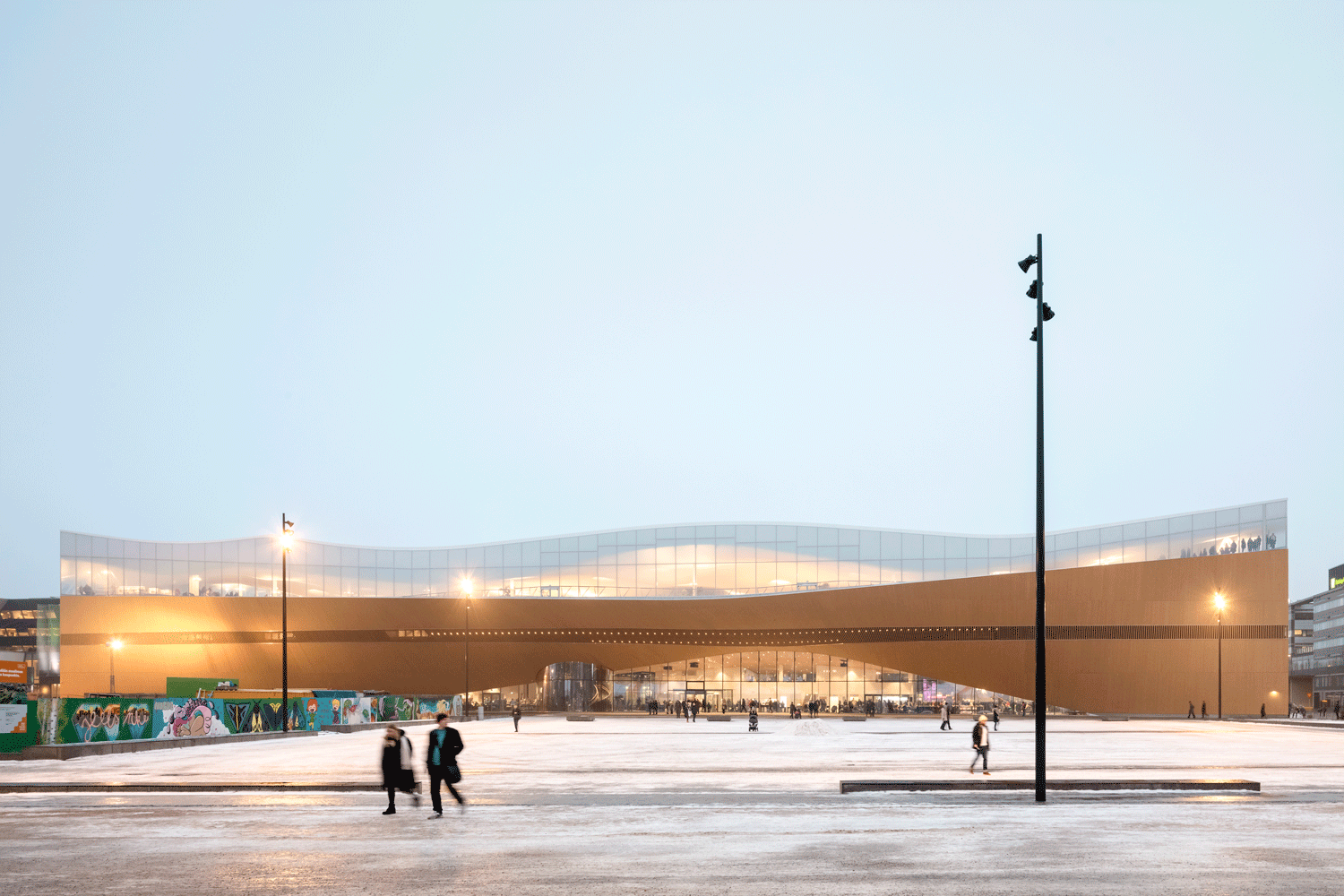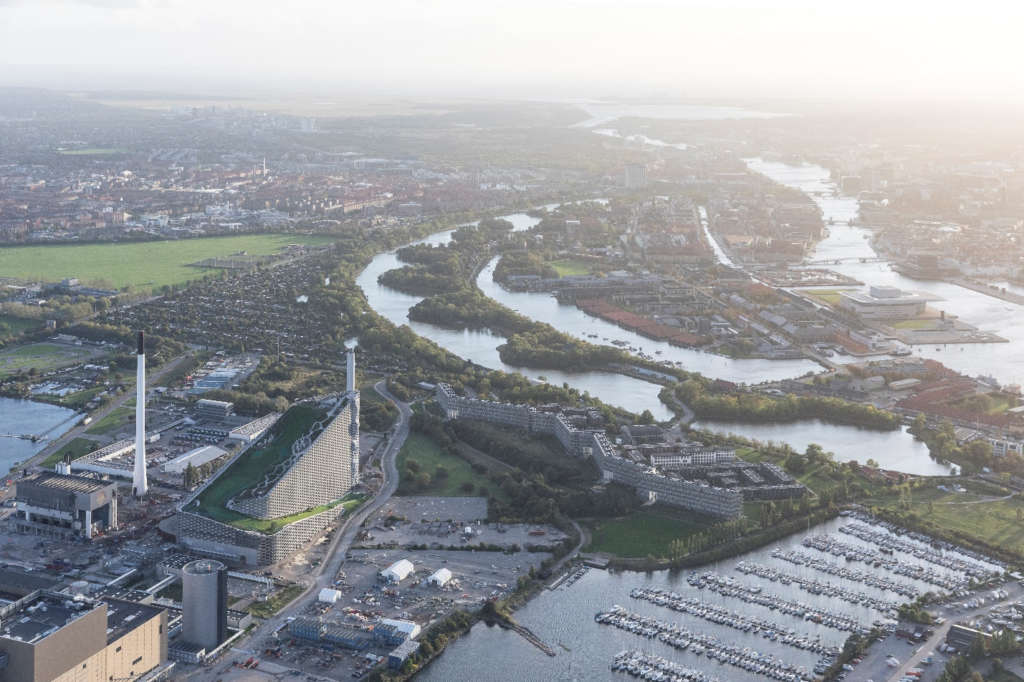
The following description is courtesy of BIG | Bjarke Ingels Group.
Designed by BIG-Bjarke Ingels Group, SLA, AKT, Lüchinger+Meyer, MOE and Rambøll, CopenHill opens as a new breed of waste-to-energy plant topped with a ski slope, hiking trail and climbing wall, embodying the notion of hedonistic sustainability while aligning with Copenhagen’s goal of becoming the world’s first carbon-neutral city by 2025.
CopenHill, also known as Amager Bakke, is a 41,000m2 waste-to-energy plant with an urban recreation center and environmental education hub, turning social infrastructure into an architectural landmark. BIG’s year-round ski plant won the international competition in 2011 and broke ground in 2013. As Denmark’s single largest waste initiative to date, Copenhagen Lord Mayor Frank Jensen officiated the first run of the slopes, commencing opening festivities from sports competitions to charity walks supporting the UN Sustainable Development Goals. CopenHill is inaugurated ahead of the C40 Mayors Summit hosted in Copenhagen this year, a landmark gathering of 96 member cities committed to bold action on climate change.
“We are very proud to have built the most energy-efficient waste-to-energy plant in the world. At the same time, the plant delivers the best environmental performance with hardly any environmental emissions, enabling us to have neighbors only 200 meters away and to be located less than 2km from the Queen’s Residence. Last but not least, we have succeeded in building the safest waste-to-energy plant so local citizens and guests from all over the world can ski on the roof.” Jacob Simonsen, Managing Director, ARC.

CopenHill is conceived as a public infrastructure with intended social side-effects from day one. Replacing the adjacent 50-year old waste-to-energy plant with Amager Ressourcecenter (ARC), CopenHill’s new waste-to-energy facilities integrate the latest technologies in waste treatment and energy production. Due to its location on the industrial waterfront of Amager, where raw industrial facilities have become the site for extreme sports from wakeboarding to go-kart racing, the new power plant adds skiing, hiking and rock climbing to thrill seekers’ wish lists.
“CopenHill is a blatant architectural expression of something that would otherwise have remained invisible: that it is the cleanest waste-to-energy power plant in the world. As a power plant, CopenHill is so clean that we have been able to turn its building mass into the bedrock of the social life of the city – its façade is climbable, its roof is hikeable and its slopes are skiable. A crystal clear example of Hedonistic Sustainability – that a sustainable city is not only better for the environment – it is also more enjoyable for the lives of its citizens.” Bjarke Ingels, Founder & Creative Director, BIG.
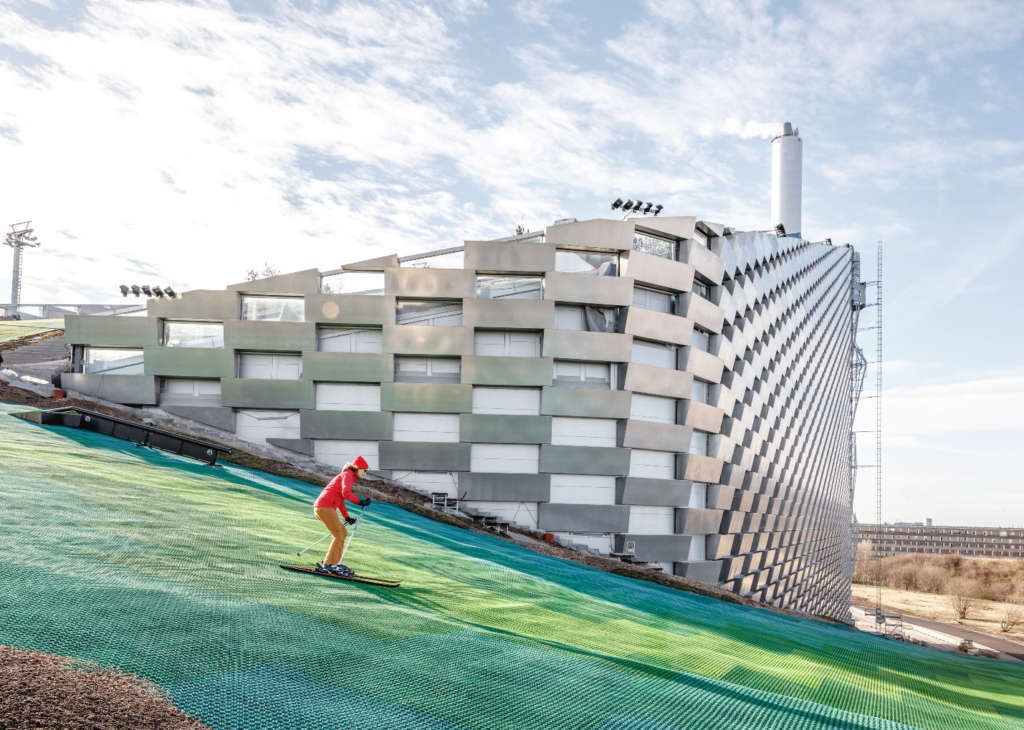
The internal volumes of the power plant are determined by the precise positioning and organization of its machinery in height order, creating an efficient, sloping rooftop fit for a 9,000m2 ski terrain. At the top, experts can glide down the artificial ski slope with the same length as an Olympic half-pipe, test the freestyle park or try the timed slalom course, while beginners and kids practice on the lower slopes. Skiers ascend the park from the platter lift, carpet lifts or glass elevator for a glimpse inside the 24-hour operations of a waste-to-plant.
“We wanted to do more than just create a beautiful skin around the factory. We wanted to add functionality! Instead of considering the Amager Ressourcecenter (ARC) as an isolated object, we mobilize the architecture and intensify the relationship between the building and the city – expanding the existing activities in the area by turning the roof of the new ARC into a ski slope for the citizens of Copenhagen. By proposing a new breed of waste-to-energy plant, one that is economically, environmentally and socially sustainable, the facility becomes part of the city and redefines the relationship between production and recreation, between energy infrastructure and social infrastructure, between factory and city.” David Zahle, Partner, BIG.
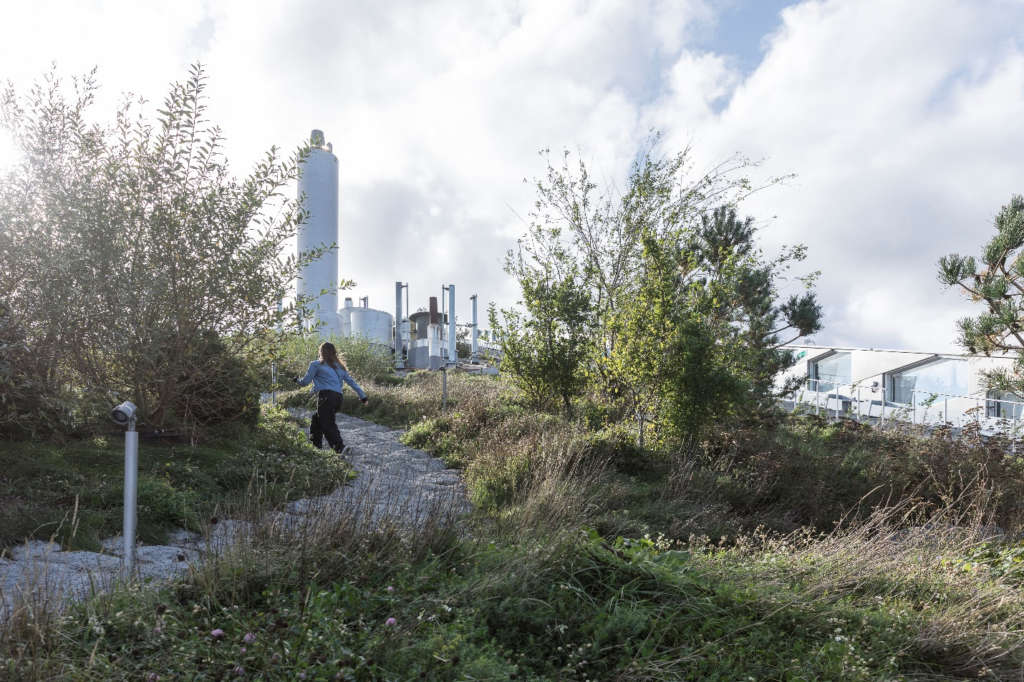
Recreation buffs and visitors reaching the summit of CopenHill will feel the novelty of a mountain in an otherwise-flat country. Non-skiers can enjoy the rooftop bar, cross-fit area, climbing wall or highest viewing plateau in the city before descending the 490m tree-lined hiking and running trail within a lush, mountainous terrain designed by Danish Landscape Architects SLA. Meanwhile, the 10,000m2 green roof addresses the challenging micro-climate of an 85m high park, rewilding a biodiverse landscape while absorbing heat, removing air particulates and minimizing stormwater runoff.
CopenHill’s nature roof park and hiking trail invites locals and visitors to traverse a mountainous landscape of plants, rockscapes, 7,000 bushes and 300 pine and willow trees atop the world’s cleanest waste-to-energy plant. It also acts as a generous ‘green gift’ that will radically green-up the adjacent industrial area. CopenHill becomes the home for birds, bees, butterflies and flowers, creating a vibrant green pocket and forming a completely new urban ecosystem for the city of Copenhagen.” Rasmus Astrup, Partner & Design Principal, SLA.
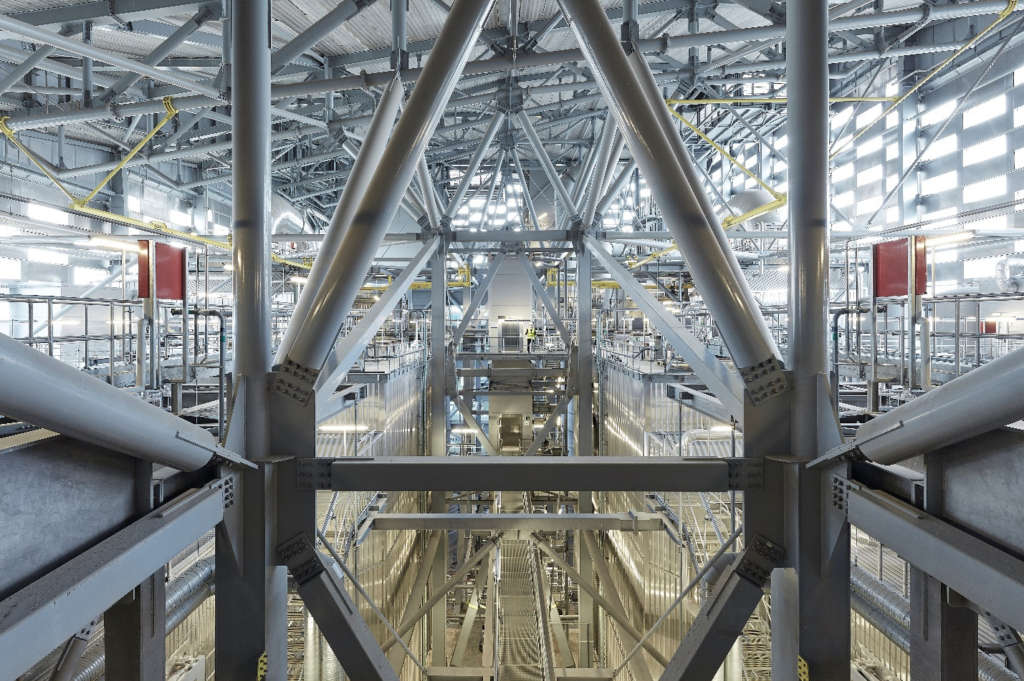
Beneath the slopes, whirring furnaces, steam, and turbines convert 440,000 tons of waste annually into enough clean energy to deliver electricity and district heating for 150,000 homes. The necessities of the power plant to complete this task, from ventilation shafts to air-intakes, help create the varied topography of a mountain; a man-made landscape created in the encounter between the needs from below and the desires from above. Ten floors of administrative space are occupied by the ARC team, including a 600m2 education center for academic tours, workshops and sustainability conferences.

Image by Rasmus Hjortshoj 
Image by Aldo Amoretti
Rather than consider ARC as an isolated architectural object, the building envelope is conceived as an opportunity for the local context while forming a destination and a reflection on the progressive vision of the company. CopenHill’s continuous façade comprises 1.2m tall and 3.3m wide aluminum bricks stacked like gigantic bricks overlapping with each other. In-between, glazed windows allow daylight to reach deep inside the facility, while larger openings on the southwest façade illuminate workstations on the administrative floors. On the longest vertical façade, an 85m climbing wall is installed to be the tallest artificial climbing wall in the world for new world records to be broken with views inside the factory.
“To me, CopenHill is a perfect example of the world-changing power of architecture. That we have the power to give form to the future that we want to live in. My son turns one next month – he won’t ever remember that there was a time when you couldn’t ski on the roof of the power plant – or climb its facades. He will take that for granted – and so will his entire generation. Clean energy and skiable power plants is going be the baseline of their imagination –the platform from which they will leap and propose new and wild ideas for their future. Standing at the peak of this humanmade mountain that we have spent the last decade creating – makes me curious and excited to see what ideas this summit may spark in the minds of future generations.” Bjarke Ingels.
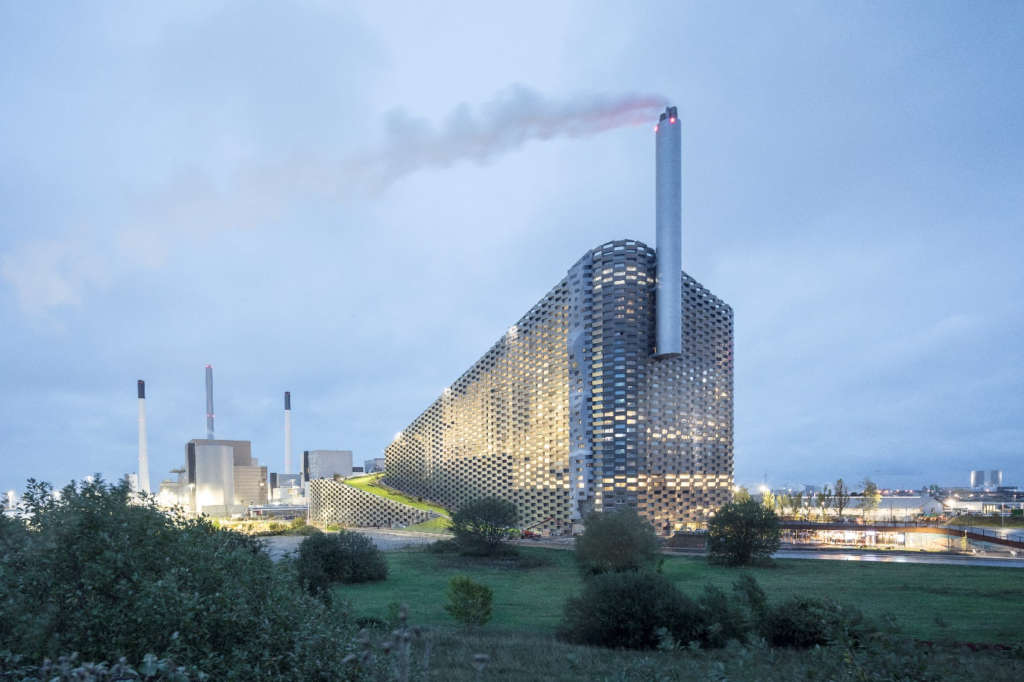
At the bottom of the ski slope, a 600m2 après-ski bar welcomes locals and visitors to wind down once the boots are off. Formerly a piece of infrastructure in an industrial zone, CopenHill becomes the new destination for families, friends and celebration, one that is economically, environmentally and socially profitable.
Learn more about CopenHill and many more BIG projects at our FORMGIVING exhibition at the Danish Architecture Center in Copenhagen, on view until January 5, 2020: https://dac.dk/en/exhibitions/formgivning-big.
Copenhill / Amager Bakke Facts
Name: CopenHill / Amager Bakke
Type: International Competition
Size: 41,000 m2 / 441,300 ft2
Location: Copenhagen, Denmark
Client: Amager Ressourcecenter
Collaborators: Detailed Design: SLA, Lüchinger+Meyer, MOE, Rambøll, Jesper Kongshaug and BIG Ideas; Competition: AKT, Topotek 1, Man Made Land, Realities:United
Thanks to: A.P. Møller Fonden, Lokale og Anlægsfonden, Nordea Fonden, Fonden R98, Københavns Kommune, Frederiksberg Kommune, Tårnby Kommune, Dragør Kommune og Hvidovre Kommune
BIG – Bjarke Ingels Group
Partners-in-Charge: Bjarke Ingels, David Zahle, Jakob Lange, Brian Yang
Project Leader: Jesper Boye Andersen, Nanna Gyldholm Møller, Claus Hermansen
Team: Alberto Cumerlato, Aleksander Wadas, Alexander Codda, Alexander Ejsing, Alexandra Gustafsson, Alina Tamosiunaite, Armor Gutierrez, Anders Hjortnæs, Andreas Klok Pedersen, Annette Jensen, Ariel Wallner, Ask Andersen, Balaj IIulian, Blake Smith, Borko Nikolic, Brygida Zawadzka, Buster Christensen, Chris Falla, Chris Zhongtian Yuan, Daniel Selensky, Dennis Rasmussen, Espen Vik, Finn Nørkjær, Franck Fdida, Gonzalo Castro, Gül Ertekin, George Abraham, Helen Chen, Henrick Poulsen, Henrik Rømer Kania, Horia Spirescu, Jakob Ohm Laursen, Jelena Vucic, Jeppe Ecklon, Ji-young Yoon, Jing Xu, Joanna Jakubowska, Johanna Nenander, Kamilla Heskje, Katarzyna Siedlecka, Krzysztof Marciszewski, Laura Wätte, Liang Wang, Lise Jessen, Long Zuo, Maciej Zawadzki, Mads Enggaard Stidsen, Marcelina Kolasinska, Marcos Bano, Maren Allen, Mathias Bank, Matti Nørgaard, Michael Andersen, Narisara Ladawal Schröder, Niklas A. Rasch, Nynne Madsen, Øssur Nolsø, Pero Vukovic, Richard Howis, Ryohei Koike, Se Hyeon Kim, Simon Masson, Sunming Lee, Toni Mateu, Xing Xiong, Zoltan David Kalaszi, Tore Banke, Yehezkiel Wiliardy





